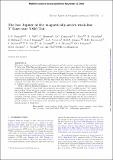Files in this item
The hot Jupiter of the magnetically-active weak-line T Tauri star V830 Tau
Item metadata
| dc.contributor.author | Donati, J.-F. | |
| dc.contributor.author | Yu, L. | |
| dc.contributor.author | Moutou, C. | |
| dc.contributor.author | Cameron, A. C. | |
| dc.contributor.author | Malo, L. | |
| dc.contributor.author | Grankin, K. | |
| dc.contributor.author | Hébrard, E. | |
| dc.contributor.author | Hussain, G. A. J. | |
| dc.contributor.author | Vidotto, A. A. | |
| dc.contributor.author | Alencar, S. H. P. | |
| dc.contributor.author | Haywood, R. D. | |
| dc.contributor.author | Bouvier, J. | |
| dc.contributor.author | Petit, P. | |
| dc.contributor.author | Takami, M. | |
| dc.contributor.author | Herczeg, G. J. | |
| dc.contributor.author | Gregory, S. G. | |
| dc.contributor.author | Jardine, M. M. | |
| dc.contributor.author | Morin, J. | |
| dc.contributor.author | MaTYSSE Collaboration | |
| dc.date.accessioned | 2016-11-17T10:30:16Z | |
| dc.date.available | 2016-11-17T10:30:16Z | |
| dc.date.issued | 2017-03-01 | |
| dc.identifier | 247676647 | |
| dc.identifier | 65a74099-4e4d-4c7e-b3a0-f13ceea1d31d | |
| dc.identifier | 000395165900057 | |
| dc.identifier | 85014671966 | |
| dc.identifier.citation | Donati , J-F , Yu , L , Moutou , C , Cameron , A C , Malo , L , Grankin , K , Hébrard , E , Hussain , G A J , Vidotto , A A , Alencar , S H P , Haywood , R D , Bouvier , J , Petit , P , Takami , M , Herczeg , G J , Gregory , S G , Jardine , M M , Morin , J & MaTYSSE Collaboration 2017 , ' The hot Jupiter of the magnetically-active weak-line T Tauri star V830 Tau ' , Monthly Notices of the Royal Astronomical Society , vol. 465 , no. 3 , pp. 3343-3360 . https://doi.org/10.1093/mnras/stw2904 | en |
| dc.identifier.issn | 0035-8711 | |
| dc.identifier.other | BibCode: 2016arXiv161102055D | |
| dc.identifier.other | ORCID: /0000-0002-8863-7828/work/58531330 | |
| dc.identifier.other | ORCID: /0000-0002-1466-5236/work/57821813 | |
| dc.identifier.uri | https://hdl.handle.net/10023/9830 | |
| dc.description.abstract | We report results of an extended spectropolarimetric and photometric monitoring of the weak-line T Tauri star V830 Tau and its recently-detected newborn close-in giant planet. Our observations, carried out within the MaTYSSE programme, were spread over 91 d, and involved the ESPaDOnS and Narval spectropolarimeters linked to the 3.6-m Canada-France-Hawaii, the 2-m Bernard Lyot and the 8-m Gemini-North Telescopes. Using Zeeman-Doppler Imaging, we characterize the surface brightness distributions, magnetic topologies and surface differential rotation of V830 Tau at the time of our observations, and demonstrate that both distributions evolve with time beyond what is expected from differential rotation. We also report that near the end of our observations, V830 Tau triggered one major flare and two weaker precursors, showing up as enhanced red-shifted emission in multiple spectral activity proxies. With 3 different filtering techniques, we model the radial velocity (RV) activity jitter (of semi-amplitude 1.2 km s−1) that V830 Tau generates, successfully retrieve the 68 ± 11 m s−1 RV planet signal hiding behind the jitter, further confirm the existence of V830 Tau b and better characterize its orbital parameters. We find that the method based on Gaussian-process regression performs best thanks to its higher ability at modelling not only the activity jitter, but also its temporal evolution over the course of our observations, and succeeds at reproducing our RV data down to a rms precision of 35 m s−1. Our result provides new observational constraints on scenarios of star / planet formation and demonstrates the scientific potential of large-scale searches for close-in giant planets around T Tauri stars. | |
| dc.format.extent | 4486516 | |
| dc.language.iso | eng | |
| dc.relation.ispartof | Monthly Notices of the Royal Astronomical Society | en |
| dc.subject | Stars: magnetic fields | en |
| dc.subject | Stars: formation | en |
| dc.subject | Stars: imaging | en |
| dc.subject | Stars: planetary systems | en |
| dc.subject | Stars: individual: V830 Tau | en |
| dc.subject | Techniques: polarimetric | en |
| dc.subject | QB Astronomy | en |
| dc.subject | QC Physics | en |
| dc.subject | NDAS | en |
| dc.subject.lcc | QB | en |
| dc.subject.lcc | QC | en |
| dc.title | The hot Jupiter of the magnetically-active weak-line T Tauri star V830 Tau | en |
| dc.type | Journal article | en |
| dc.contributor.sponsor | Science & Technology Facilities Council | en |
| dc.contributor.sponsor | Science & Technology Facilities Council | en |
| dc.contributor.sponsor | Science & Technology Facilities Council | en |
| dc.contributor.sponsor | PPARC - Now STFC | en |
| dc.contributor.sponsor | Science & Technology Facilities Council | en |
| dc.contributor.institution | University of St Andrews. School of Physics and Astronomy | en |
| dc.contributor.institution | University of St Andrews. St Andrews Centre for Exoplanet Science | en |
| dc.identifier.doi | 10.1093/mnras/stw2904 | |
| dc.description.status | Peer reviewed | en |
| dc.identifier.url | https://arxiv.org/abs/1611.02055 | en |
| dc.identifier.grantnumber | ST/J003255/1 | en |
| dc.identifier.grantnumber | ST/M001296/1 | en |
| dc.identifier.grantnumber | ST/I000666/1 | en |
| dc.identifier.grantnumber | PP/D000890/1 | en |
| dc.identifier.grantnumber | ST/G001006/1 | en |
This item appears in the following Collection(s)
Items in the St Andrews Research Repository are protected by copyright, with all rights reserved, unless otherwise indicated.

